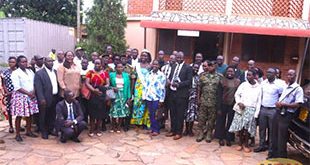
Dr. Eddie Mukoyo, the Assistant Commissioner, Resources, at the Ministry of Health has said Uganda’s remarkable fight against epidemics such as Ebola and Marburg is to a large extent down to the ministry’s swift adoption of mobile health applications.
Dr. Mukoyo was speaking at this month’s Mobile Monday Kampala (MoMoKla) event, a community of mobile industry visionaries and mobile application developers who meet every first Monday of the month to network, share ideas, best practices and trends from global markets.
This month’s event hosted by ThoughtWorks, a global custom software company based at Nakawa’s Business Park dwelt more on how mhealth tools have helped to contain outbreaks like Ebola in Uganda.
Mukoyo said November’s topic could not have come sooner considering that the Ebola epidemic has ravaged three West African countries of Guinea, Liberia and Sierra Leone. Other outbreaks have been reported in Nigeria, Senegal and Mali over the last three months.
Many global health experts say the Ebola epidemic partly escalated in West Africa because of the respective governments’ failure to deal with the local people’s suspicion and mistrust. A rapid mobile-phone response from these governments could have helped to cut back on the infection rates.
At the moment, the World Health Organization (WHO) says although the official death toll is said to be hovering around 5,000, the number is likely to be three times higher.
Among the dead are 244 healthcare workers—a stark reminder that supporting frontline health workers is vital and there is critical need to establish a more robust communications and data collection system between health workers and their supervisors as they address priority needs.
At the Mobile Monday event held on Nov. 3, Mukoyo said some of the mobile application innovations that are being hatched in Kampala’s hubs had in recent years become valuable in the fight against epidemics like Ebola and Marburg.
One of the latest innovations that have come in handy at the ministry is the District Health Information System (DHISII) which is an open source, web-based software platform that captures, analyses and disseminates data.
The Ministry is banking on this UNICEF-supported project to form a core pillar of the country’s eHealth Information System.
According to Edward Bichetero, the Systems Administrator at the health ministry, this has been useful in producing weekly surveillance reports on the most infectious diseases from all government health facilities in all the 112 districts of Uganda.
“Using this system, all [government] health facilities have to deliver the reports to the Ministry of Health every Monday morning,” he said.
Mukoyo said by deploying various Mobile applications, the ministry is now focused on providing the appropriate level of service ‘anytime,’ ‘everywhere’ for ‘everyone.’
Besides improving upon the number of health workers and providing medicine and other medical supplies at a cheaper cost, the ministry is focusing on reducing infections and health events in the individual and the community.
It is doing this by reducing the distance travelled to access a public or private facility; the time to diagnose a medical condition in an individual or community and by reducing errors in diagnosis.
Mukoyo said significant investments have been made in a variety of the health ministry’s owned systems, including DHISII, iHRIS, CHMS and RapidPro.
“These tools are now beginning to work in an integrated environment,” he said.
“By developing a strong information system at the household, community, facility, district and national levels, this will provide the foundation for real time information sharing.”
Mukoyo said with the rapid adoption of these mobile devices and applications, the health ministry and partners are now able to interact more directly with communities, and respond much quicker, than in the past years.
As an example, Mukoyo said the ministry’s mTrac Anonymous Hotline was receiving over 2,500 reports per week in October after a case of Marburg was confirmed and the resource centre was able to provide the Epidemiological Surveillance Department with regular updates on potential new outbreaks, all of which were immediately investigated and turned out not to be Marburg.
Mukoyo noted that the health ministry is now coming up with a strategy to utilize existing mobile applications to fight disease burden.
In future, he said, the ministry is planning to get an innovation hub supported by students studying in all Uganda’s academic institutions and link the hub to households, communities, districts and the national health facilities.
In the next three months, the ministry together with its partners will deploy the community management system in five districts as a pilot project. The tools are supposed to dramatically improve the appalling health indices in Uganda.
The mobile application developers at the forum gave insights into how the healthcare ecosystem works, described existing and emerging tools and policies, and how developers can make it more efficient using existing infrastructure through harmonization of tools.
They argued that tools such as the DHISII, iHRIS, Rapid Pro if integrated through emerging health standards can provide the backbone for the entire country’s communication and strategic health information network.
According to Ismail Wadembere, the Informatics Manager at Intrahealth, an organization that is implementing the USAID-Uganda Strengthening Human Resources for Health project, the Rapid Pro is a tool that is being developed to serve as the national communications engine, pulling in data from health workforce registries and sending data back into national databases, such as DHISII.
Many mobile health experts say the improved visibility afforded by these tools and adoption of emerging standards, will allow integration of systems to provide enterprise level management of healthcare and better preparedness for earlier detection of possible outbreaks by improved surveillance methods and, in turn, enable a smarter, more rapid response by health officials to any perceived threat.
The experts also agree that by leveraging existing infrastructure, tools, with an enterprise level healthcare infrastructure management approach, this could provide opportunities for improving efficiency, thus providing better healthcare.
“The hope is that the more circumspect view afforded by the use of these new tools, in adherence to the new standards, will allow for earlier detection of possible outbreaks, by better surveillance methods, that, in turn enables a smarter, more rapid responses by officials to contain the threat of an outbreak,” noted a brief on the topic.
 The Independent Uganda: You get the Truth we Pay the Price
The Independent Uganda: You get the Truth we Pay the Price



